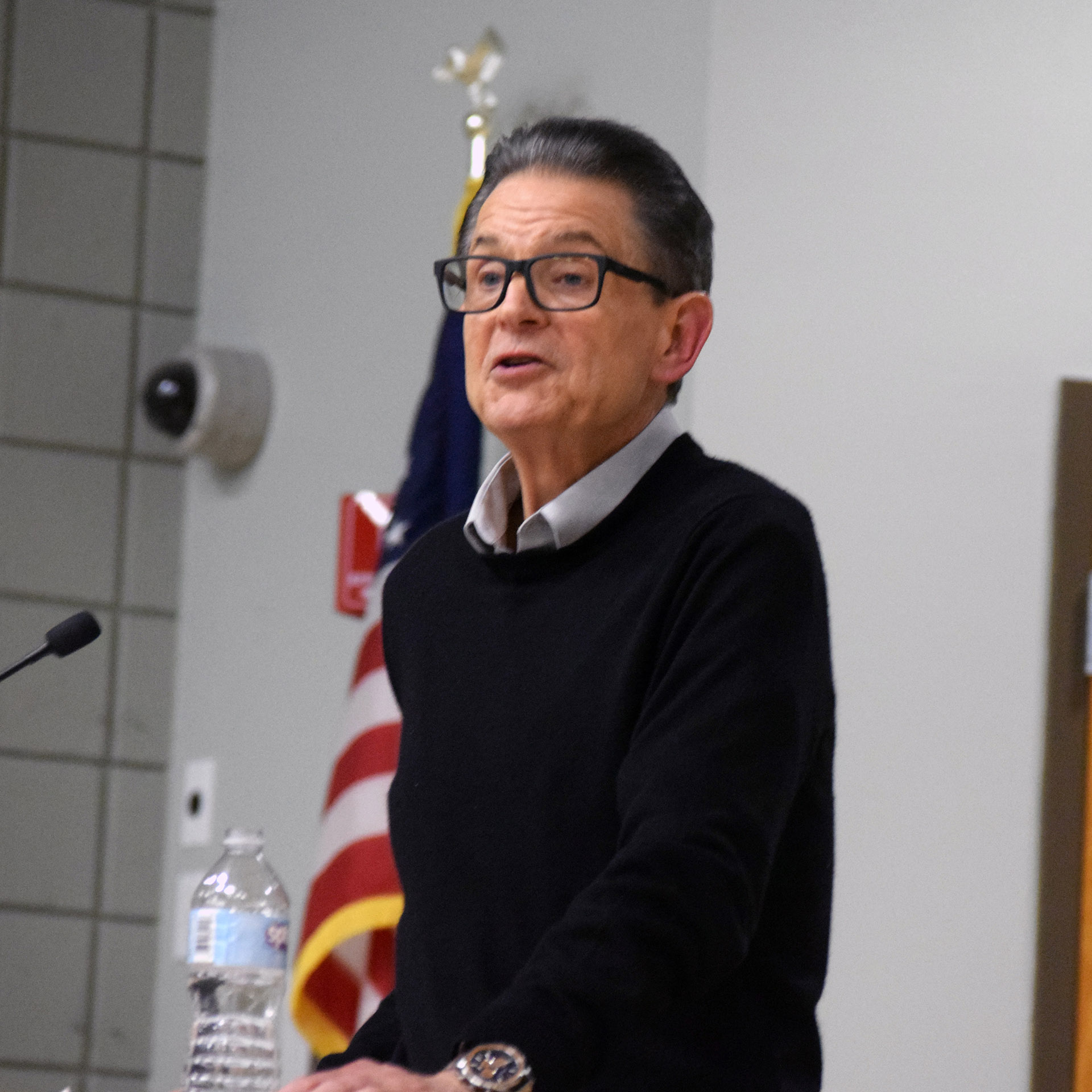
News
Ricker Writing Textbook on Serial Killers
Published on November 14, 2025 - 4 p.m.
Southwestern Michigan College Criminal Justice Professor Dr. Don Ricker is writing the book on serial killers.
A textbook, no less. He signed a contract with Kendall-Hunt Publishing of Dubuque, Iowa, with a target release date in January 2027 and recently submitted his first chapter.
In the meantime, the former Houston detective who has directed SMC’s CJ program since 2014, presented the Nov. 13 Academic Speaker Series talk, “Understanding Serial Murder: Theory, Research and Practice” at the Student Activity Center theatre, astounding students, former students and faculty and staff colleagues with his mastery of less sensational aspects of what can be a gruesome topic.
Ricker explored what motivates serial killers, how researchers study them and how this knowledge is used in real-world investigations. He covered key theories, case studies and insights from psychology and criminal justice.
“Did you know the Jack the Ripper case has been solved?” Ricker began. It took nearly 140 years, but one of history’s oldest mysteries is believed to have been cleared in 2019 when DNA found on a shawl recovered from the scene of a grisly slaying pointed to Polish hairdresser Aaron Kosminski, 23, who died in a mental institution in 1919, for terrorizing Victorian London’s East End in the late 1800s.
“He was one of three suspects,” Ricker said. “Thanks to DNA, facial recognition and video, there are less kills per serial murderer.”
Ricker noted that the FBI changed its definition, reducing the number of victims from three to two.
“Methods to commit homicides are a big change I’ve seen,” Ricker said.
One serial murderer of particular interest to Ricker is 6-foot-9 Edmund Kemper, 76, the “Coed Killer,” who murdered his grandparents at 15 and, after being paroled, killed eight women, including his mother, between May 1972-April 1973.
“Kemper was one of 36 incarcerated serial murderers the FBI interviewed to create its profiling system,” Ricker said.
“Strangulations and stabbings in the 1970s have been replaced by guns. Firearms are being used a lot more,” Ricker said. “Today we see more mass murder,” such as the Oct. 1, 2017, Las Vegas shooting by Stephen Paddock, 64, who opened fire from the 32nd floor of the Mandalay Bay hotel with more than 1,000 rounds, using bump stocks to simulate automatic weapons. Paddock killed 60 people and wounded at least 413 others attending a music festival.
On Aug. 1, 1966, Marine Charles Whitman ascended the University of Texas Tower and committed what was then the largest simultaneous mass murder in American history, gunning down 45 people inside and around the tower before he was killed by two Austin police officers. He killed his wife and mother the previous evening.
“Mass murder is a big problem today,” Ricker said. “Soft targets seem to attract these individuals. I have many Houston friends working extra security jobs. Every church has one.”
Ricker touched on numerous mass shootings, from Columbine and Aurora, Colo., and Virginia Tech to Uvalde, Texas, Marjory Stoneman Douglas High School in Parkland, Fla., Michigan State, the 2017 Delphi, Ind., murders of Abigail Williams and Liberty German, and individuals such as Ed Gein and Jeffrey Dahmer.
“Expressive serial murder is very common in males,” Ricker said, “because their motivation might be sexual. Females are more instrumental — motivated by money,” like widow Belle Gunness of LaPorte, Ind., who placed ads for reliable men to become farming partners.
“Some male serial killers have targeted children. Albert Fish, the ‘Vampire of Brooklyn,’ was sadistic. He was executed in 1936. But most of the time they target adults, usually females.”
“Some kill in more than one state. Ted Bundy did and Israel Keyes,” who took his own life in 2012 while awaiting trial. Keyes murdered at least three people while committing at least 20 other crimes across the United States, including arsons, burglaries and bank robberies.
Bundy, executed in 1989 at 42, kidnapped, raped and murdered dozens of young women and girls between 1974-78 moving between Washington, Oregon, Colorado, Utah and Idaho.
“Male serial killers do not kill family members normally,” Ricker said. “Eighty-four percent of the time they go after strangers.”
Referring to Keyes, who inspired Maureen Callahan’s 2019 book American Predator: The Hunt for the Most Meticulous Serial Killer of the 21st Century, Ricker said, “A lot of these guys have military backgrounds,” an aspect he hopes to explore in future research.
“The most prolific American serial murderer is Samuel Little, who died in 2020.” Little confessed to 93 murders by strangulation between 1970-2005.
“Travelers who are constantly moving are the hardest to catch,” Ricker said. “Trauma and rejection are big factors for all serial murderers, whether male or female.”
The controversial 1963 MacDonald Triad theorized that a combination of three childhood behaviors — animal cruelty, fire-setting and bed-wetting — predicted future violent behavior.
Ricker also pointed out the more menacing nicknames bestowed on men versus women, such as the “Giggling Granny,“ Nannie Doss, responsible for the deaths of 11 people between 1927-1954.
When Adam Lanza, 20, shot and killed 26 people at Sandy Hook Elementary School in Newtown, Conn., including 20 children ages 6 and 7, on Dec. 14, 2012, “That hit me super hard” because his twin daughters were 7.






